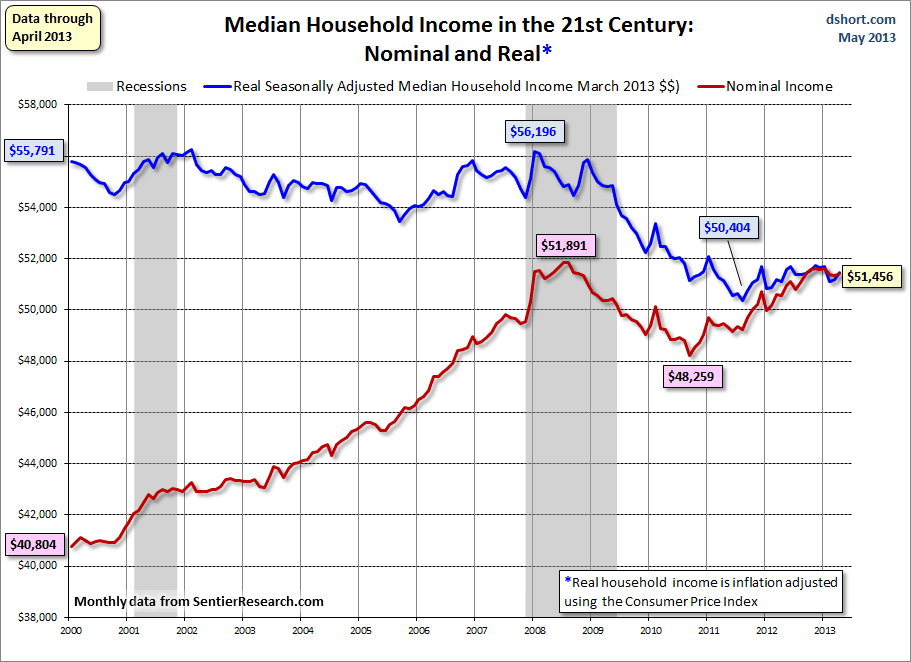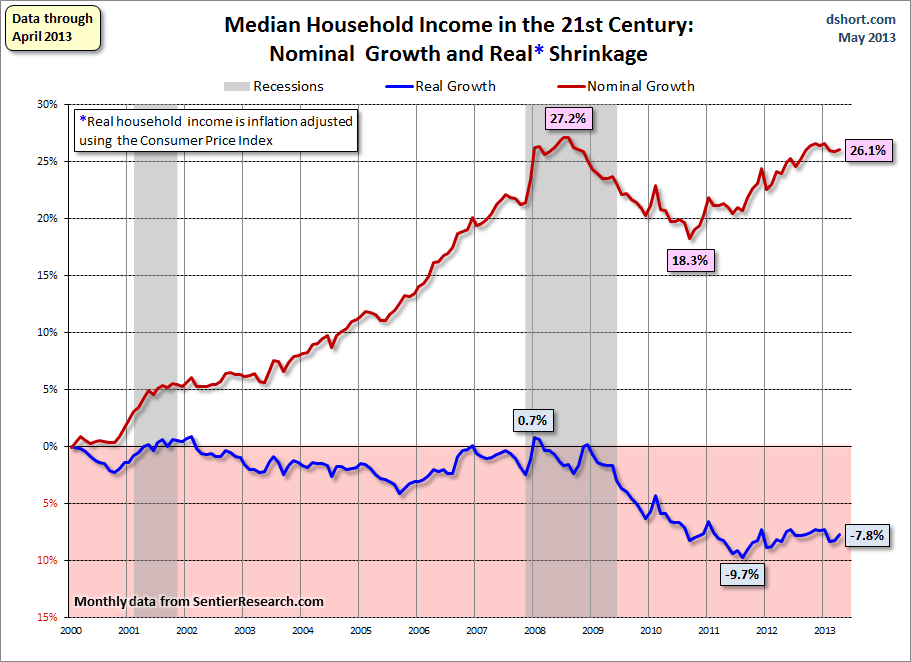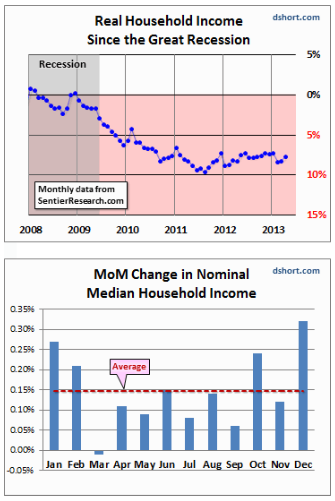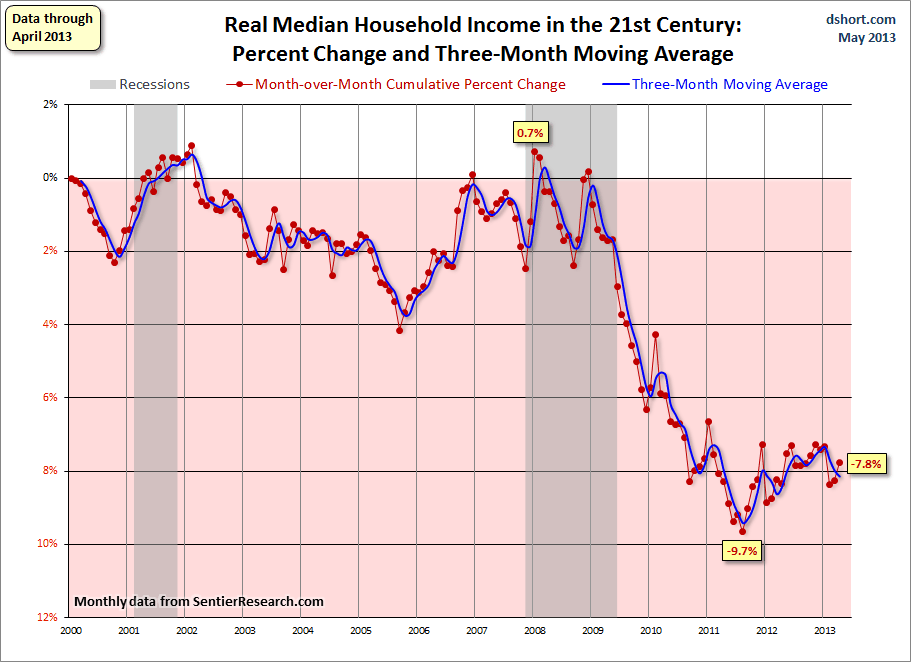Overview: The Sentier Research monthly median household income data series is now available for April. Nominal median household incomes were up $77 month-over-month and $877 year-over-year. However, adjusted for inflation, real incomes rose $266 (0.5%) MoM but are up only $317 (0.6%) YoY. The reason for the counterintuitive larger increase in MoM real incomes is that the Consumer Price Index for April dropped 0.4% from the previous month.
The traditional source of household income data is the Census Bureau, which publishes annual household income data each September for the previous year.
Sentier Research, an organization that focuses on income and demographics, offers a more up-to-date glimpse of household incomes by accessing the Census Bureau data and publishing monthly updates. Sentier Research has now released its most recent update, data through April (available here). The data in their report differs from the Census Bureau's data in three key respects:
This latest reading on real median annual household income reflects, to a large extent, the reduction in consumer prices of 0.4 percent between March 2013 and April 2013. Even though we are technically in an economic recovery, the most recent experience suggests that real median annual household income is still having difficulty gaining any solid traction. We are watching this household income series closely for signs of any sustained directional movement.
As for the data itself, Sentier makes it available in Excel format for a small fee (here). I have used the latest data to create a pair of charts illustrating the nominal and real income trends during the 21st century.
The first chart below chains the nominal values and real monthly values in April 2013 dollars. The red line illustrates the history of nominal median household income in today's dollars (as of the designated month). I've added callouts to show the latest value and the real monthly values for January 2000 and the peak and post-peak trough in between.

The blue line in the chart above paints the grim "real" picture. Since we've chained in April 2013 dollars and the overall timeframe has been inflationary, the earlier monthly values are adjusted upward accordingly. In addition to the obvious difference in earlier real values, we can also see that real incomes peaked before the nominal (January of 2008, one month after the recession began, versus July 2008). Also the real post-recession decline bottomed later than the nominal (August 2011 versus September 2010).
The next chart is my preferred way to show the nominal and real household income -- the percent change over time. Essentially I have taken the monthly series for both the nominal and real household incomes and divided them by their respective values at the beginning of 2000. The advantage to this approach is that it clearly quantifies the changes in both series and avoids a common distraction of using dollar amounts ("How does my household stack up?").

The stunning reality illustrated here is that the real median household income series spent most of the first nine years of the 21st century struggling slightly below its purchasing power at the turn of the century. Real incomes (the blue line) peaked at a fractional 0.7% in early 2008, far below the nominal illusionary peak (as in money illusion) of 27.2% six months later. Also the real recovery from the trough has been depressingly slight.
Let's take a closer look at the monthly data since the end of the Great Recession. The adjacent chart highlights the real monthly median values since 2008. The right axis shows the same scale as the chart above -- the percent change from the real household income value at the start of the 21st century. The April 2013 real median annual income ($51,456) is 0.5% below its interim high five months ago in November ($51,733). But the actual household experience is worse than these numbers suggest. The Sentier calculations are based on pre-tax data. The expiration of the 2% FICA tax has put a substantial hit on disposable household incomes.

Is there seasonality to the monthly data? The column chart shows the monthly averages of nominal month-over-month change since 2000. December is the top performer with January a close second. March has a negative average since the turn of the century. However, the month-over-month volatility of the Consumer Price Index reduces the reliability of the nominal pattern as a clue for what to expect in the in the months ahead.
In Summary...
As the excellent data from Sentier Research makes clear, the mainstream U.S. household was struggling before the Great Recession. At this point, real household incomes are in significantly worse shape than they were over three years ago when the recession ended.
I'll close this update with another look at real growth, highlighting the actual monthly data points and adding a three-month moving average. The MA trend has been zigzagging higher since the trough in 2011, although the trend in 2013 appears to have reversed.

Check back next month for the latest update.
Additional Reading:
Note: For more information on the Census Bureau's Current Population Survey (CPS), visit the CPS Frequently Asked Questions page. A question I've often been asked over the years is what qualifies as income in CPS household survey. The CPS definitons pagelists the following:
The traditional source of household income data is the Census Bureau, which publishes annual household income data each September for the previous year.
Sentier Research, an organization that focuses on income and demographics, offers a more up-to-date glimpse of household incomes by accessing the Census Bureau data and publishing monthly updates. Sentier Research has now released its most recent update, data through April (available here). The data in their report differs from the Census Bureau's data in three key respects:
- It is a monthly rather than annual series, which gives a more granular view of trends.
- Their numbers are more current, the latest through April 2012. In September the Census Bureau released the 2011 annual numbers (going on nine months into the next year).
- Sentier Research uses the more familiar Consumer Price Index (CPI) for the inflation adjustment. The Census Bureau uses the little-known CPI-U-RS (RS stands for "research series") as the deflator for their annual data. For more on that topic, see this commentary.
This latest reading on real median annual household income reflects, to a large extent, the reduction in consumer prices of 0.4 percent between March 2013 and April 2013. Even though we are technically in an economic recovery, the most recent experience suggests that real median annual household income is still having difficulty gaining any solid traction. We are watching this household income series closely for signs of any sustained directional movement.
As for the data itself, Sentier makes it available in Excel format for a small fee (here). I have used the latest data to create a pair of charts illustrating the nominal and real income trends during the 21st century.
The first chart below chains the nominal values and real monthly values in April 2013 dollars. The red line illustrates the history of nominal median household income in today's dollars (as of the designated month). I've added callouts to show the latest value and the real monthly values for January 2000 and the peak and post-peak trough in between.

The blue line in the chart above paints the grim "real" picture. Since we've chained in April 2013 dollars and the overall timeframe has been inflationary, the earlier monthly values are adjusted upward accordingly. In addition to the obvious difference in earlier real values, we can also see that real incomes peaked before the nominal (January of 2008, one month after the recession began, versus July 2008). Also the real post-recession decline bottomed later than the nominal (August 2011 versus September 2010).
The next chart is my preferred way to show the nominal and real household income -- the percent change over time. Essentially I have taken the monthly series for both the nominal and real household incomes and divided them by their respective values at the beginning of 2000. The advantage to this approach is that it clearly quantifies the changes in both series and avoids a common distraction of using dollar amounts ("How does my household stack up?").

The stunning reality illustrated here is that the real median household income series spent most of the first nine years of the 21st century struggling slightly below its purchasing power at the turn of the century. Real incomes (the blue line) peaked at a fractional 0.7% in early 2008, far below the nominal illusionary peak (as in money illusion) of 27.2% six months later. Also the real recovery from the trough has been depressingly slight.
Let's take a closer look at the monthly data since the end of the Great Recession. The adjacent chart highlights the real monthly median values since 2008. The right axis shows the same scale as the chart above -- the percent change from the real household income value at the start of the 21st century. The April 2013 real median annual income ($51,456) is 0.5% below its interim high five months ago in November ($51,733). But the actual household experience is worse than these numbers suggest. The Sentier calculations are based on pre-tax data. The expiration of the 2% FICA tax has put a substantial hit on disposable household incomes.

Is there seasonality to the monthly data? The column chart shows the monthly averages of nominal month-over-month change since 2000. December is the top performer with January a close second. March has a negative average since the turn of the century. However, the month-over-month volatility of the Consumer Price Index reduces the reliability of the nominal pattern as a clue for what to expect in the in the months ahead.
In Summary...
As the excellent data from Sentier Research makes clear, the mainstream U.S. household was struggling before the Great Recession. At this point, real household incomes are in significantly worse shape than they were over three years ago when the recession ended.
I'll close this update with another look at real growth, highlighting the actual monthly data points and adding a three-month moving average. The MA trend has been zigzagging higher since the trough in 2011, although the trend in 2013 appears to have reversed.

Check back next month for the latest update.
Additional Reading:
- U.S. Household Incomes: A 44-Year Perspective
- U.S. Median Household Incomes by Age Bracket: 2011 Was a Bleak Year
- Median Household Income Growth: Deflating the American Dream
Note: For more information on the Census Bureau's Current Population Survey (CPS), visit the CPS Frequently Asked Questions page. A question I've often been asked over the years is what qualifies as income in CPS household survey. The CPS definitons pagelists the following:
- Earnings
- Unemployment compensation
- Workers' compensation
- Social security
- Supplemental security income
- Public assistance
- Veterans' payments
- Survivor benefits
- Disability benefits
- Pension or retirement income
- Interest
- Dividends
- Rents, royalties, and estates and trusts
- Educational assistance
- Alimony
- Child support
- Financial assistance from outside of the household
- Other income
